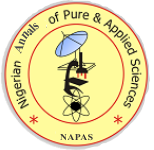Identification of Fungi Colonizing the Rhizopshere of Tomato (Solanum lycopersicum) Plants and their Pathogenicity on Healthy Tomato Fruits
Keywords:
Fungi, rhizosphere, tomato plants, Pathogenicity, tomato fruitsAbstract
Soil is a complex natural resource that represents a vast reservoir of biodiversity with several
billion prokaryotic and eukaryotic microorganisms. A study was carried out to identify fungal
organisms colonizing the rhizosphere of tomato plants in Makurdi and to test their
pathogenicity on healthy tomato fruits. Soil samples were collected from the rhizosphere of
tomato plantations at Akpehe, Wurukum area of Makurdi. The soil samples were placed in
polyethylene envelopes and taken to the Botany Laboratory of the Benue State University
Makurdi for isolation of fungi. Fungi isolation was done using the serial dilution method.
Exactly 1 ml of 10 -4 dilution level of the inoculums were placed in Petri dishes after which
molten Sabouraud agar was aseptically introduced and incubated at room temperature for 5-7
days. Data collected were analyzed using Analysis of Variance and Chi-square. The results
showed that six fungi were isolated from the soil samples namely; Aspergillus niger,
Aspergillus fumigatus, Rhizopus stolonifer, Fusarium sp, Penicillium sp and Curvularia sp.
The frequency of fungi occurrence in the soil samples was significant across species (χ 2 =
17.20, df = 5. P=0.01). Aspergillus niger had the highest occurrence 10 (26.32%), followed
by Rhizopus stolonifer and Aspergillus fumigatus each with 7 (18.42%) respectively,
Fusarium sp 6 (15.79), Penicillium sp. 5 (13.16%) and the least occurrence was Curvularia
sp. 3 (7.89%). Pathogenicity test revealed that rot induced by Rhizopus stolonifer was
significantly higher (10.52cm 2 ) on tomato fruits compared with that induced by Aspergillus
fumigatus (7.30cm 2 ), Aspergillus niger (6.87cm 2 ), Penicillium sp. (5.20 cm 2 ), Curvularia sp.
(5.00cm 2 ), Fusarium sp. (4.21cm 2 ) and the lowest was recorded in the uninoculated (control)
(1.45cm 2 ) fruits. The isolated soil borne fungi were pathogenic when inoculated on healthy
tomato fruits. Further research should be carriedout on the effect, identification and
interaction of both pathogenic and beneficial rhizosperic fungi on growth and development of
plants.
References
Acosta-Martínez, V., Cotton, J., Gardner, T., Moore-Kucera, J., Zak, J. and Wester, D. (2014). Predominant bacterial and fungal assemblages in agricultural soils during a record drought/heat wave and linkages to enzyme activities of biogeochemical cycling. Applied Soil Ecology. 84:69–82.
Chen, Y. L., Xu, T. L., Veresoglou, S. D., Hu, H. W., Hao, Z. P. and Hu, Y. J. (2017). Plant diversity represents the prevalent determinant of soil fungal community structure across temperate grasslands in northern China. Soil Biology Biochemistry, 110: 12–21.
Dawar, S., Batool, M., Tariq, M. and Zaki, M.J. (2014). Mycoflora in the rhizosphere of some wild plants around Karachi University Campus. Pakistan Journal of Botany, 46(1):369-37314
Ebimieowei, E. and Ebideseghabofa, E. (2013b). Postharvest Quality of Commercial Tomato
(Lycopersicon Esculentum Mill.) Fruits Brought into Yenagoa Metropolis from Northern Nigeria. Journal of Biology, Agriculture and Healthcare, 3 (11): 8-15
Ekhumelo, C., Yaaju, M.D. and Taaju, M.S. (2016). Identification and Management of fungi associated with crown rot of banana in Makurdi, Benue State, Nigeria. Nigerian Journal of Agriculture, Food and Environment, 13 (2): 50-55
Ezebeikwe, I.O. and Ibe, A.E. (2010). Fungi associated with Postharvest rot of white yam
(Dioscorea rotundata). Journal of Food Processing and Technology, 7: 642.
FAOSTAT (Food and Agriculture Organization of the United Nations) (2013). Data, various
years. Pp. 21-35.
Liamngee, K., Kalu, O.J and Oche, O.D. (2015). Assessing the Biocontrol potential of Trichoderma species on Sclerotia rot disease of tomato plants in Chile Island (Makurdi). IOSR Journal of Environmental Science, Toxicology and Food Technology, 9(4)51-58.
Liamngee, K., Ogo-Oluwa, A. T. and Akinyemi, B. K. (2016). Isolation and Identification of Seed Borne Fungi of Common Bean (Phaseolus vulgaris) from selected Markets in Makurdi. International Journal of Applied Agricultural Sciences, 2 (5): 75-78.
Mwekaven, S.S., Wanen-Ikyo, T., Alye, C.T. and Aorkwagh, M.T. (2019). Identification and enumeration of microorganisms associated with post harvest spoilage of tomatoes (Lycopersicum esculentum) sold in Gboko Metropolis. Journal of Scientific and Engineering Research, 6 (6): 153-158.
Naika, S., Juede, J., Goffau, M., Hilmi, M. and Dam, V. (2005). “ Cultivation of Tomato” Production, processing and marketing, Agromisa/ CTA. Revised edition, 2005 Agrodok- series No 17
Ngongu, I., Ugese, D.F., Liamngee, K. and Agatsa, D.T. (2018). Isolation and identification of fungi causing postharvest decay of oranges (Citrus sinensis) during storage in Makurdi. Mind Sourcing Bio, 3 (12): 1-8.
Olayemi, F. F., Adegbola, J. A., Bamishaiye, E. I. and Daura, A. M. (2010). Assessment of Post-Harvest Challenges of Small Scale Farm Holders of Tomatoes, Bell and Hot Pepper in Some Local Government Areas of Kano State, Nigeria. Bayero Journal of Pure and Applied Sciences,3(2): 39 – 42.
Onaebi, C.N., Okoro, A.C. and Anyaogu, E. (2020). Fungal diversity in the rhizosphere and rhizoplane of Okra (Abelmoschus esculentus) in Nsukka, Enugu State, Nigeria, Annual Research and Review in Biology, 35 (3):14-22
Oyeyiola, G.P. (2008) Rhizosphere Mycoflora of Okra (Hibiscus esculentus). Research
Journal of Soil Biology,1:31-36
Sajad, A.M., Jamaluddin, O. and Abid, H.Q. (2017). Fungi associated with the spoilage of post harvest tomato fruits and their frequency of occurrences in different markets of Jabalpur, Madhya-Pradesh India. International Journal of Current Research Revolution, 9 (5): 12-18.
Shankara, N., Joep van Lidt, J., Marja, G., Martin, H. and Barbara, D. (2005). Cultivation of Tomato: Production, Processing and Marketing. Digigrafi, Netherlands. Pp.87-93
Shinkafi, S.A. and Gobi, M.A. (2018). Isolation and identification of rhizospheic mycoflora of tomato (Lycopersicum esculentum). Advances in Plants and Agriculture Research, 8 (6) : 512-515.
Silva, J.M., Dalbou, V.A., Massachud, T.R. and Lima, G.S. (2022). Isolation and molecular identification of rhizopsheric fungi associated with Opuntia ochenllifera from semi-arid in Algoas Brazil. International Journal of Agriculture and Biology, 3 (10): 34-43
Six, J., Bossuyt, E.T., Degryzr, S. and Dene, K. (2004). A history of research on the link between (micro) aggregates, soil biota, and soil organic matter dynamics., Soil Tillage Research, 79:7–31
Yao, Q., Liu, J., Yu, Z., Li, Y., Jin, J. and Liu, X. (2017). Three years of biochar amendment alters soil physiochemical properties and fungal community composition in a black soil of northeast China. Soil Biology Biochemistry, 110: 56–67
Zhang, H., Zheng, X. and Ting, Y. (2007). Biocontrol of postharvest diseases of peach with
Crytococccus laurentii. Food Control, 18 (4): 287-29
Downloads
Published
How to Cite
Issue
Section
License
Copyright (c) 2023 Liamgee K, Awua Y., Fayinminu A.O., Anshi S.J.

This work is licensed under a Creative Commons Attribution-ShareAlike 4.0 International License.



 Contact Us
Contact Us Editorial Team
Editorial Team Join As A Reviewer
Join As A Reviewer  Request For Print Copy
Request For Print Copy


 Cprint Publishers
Cprint Publishers